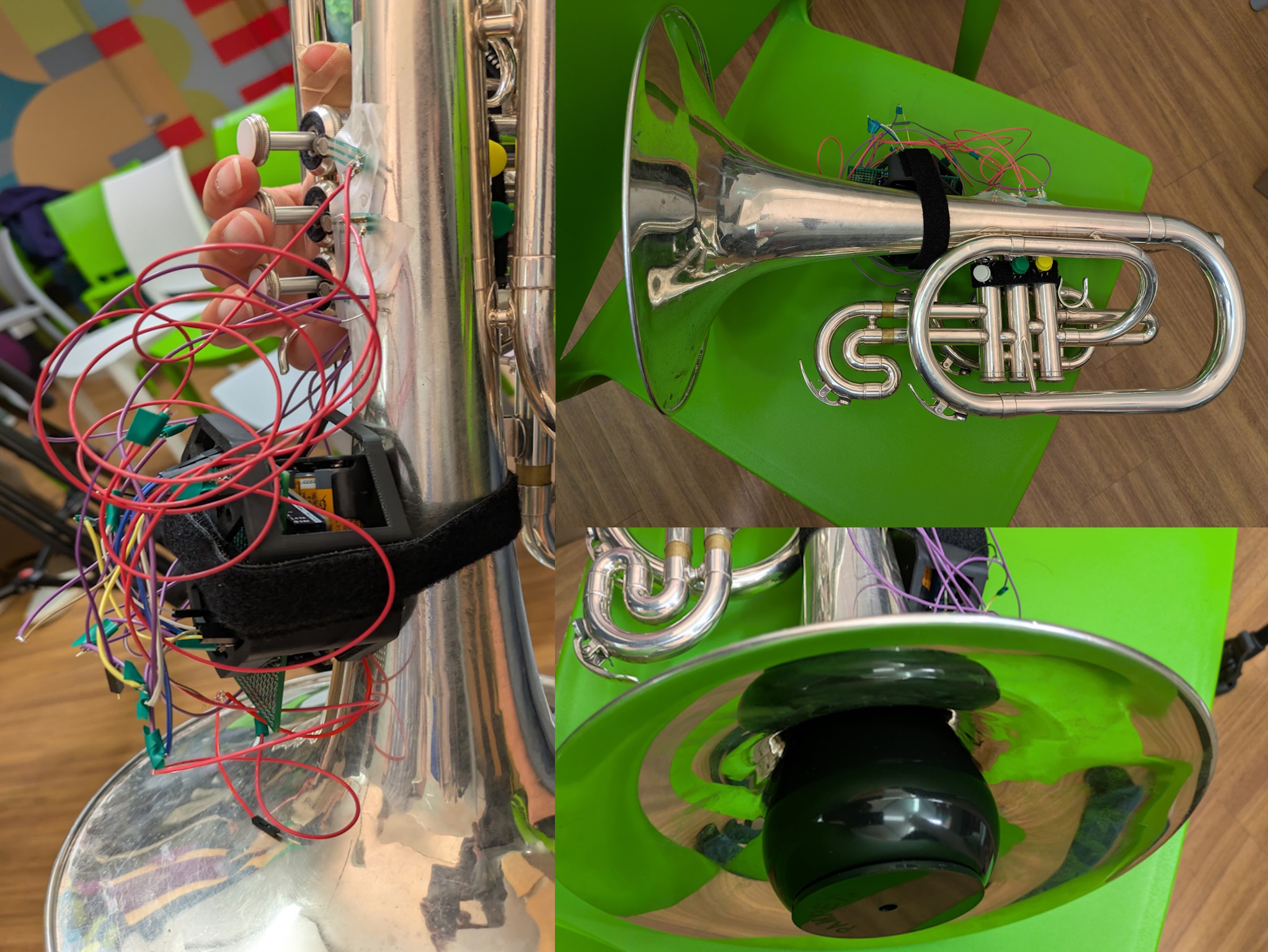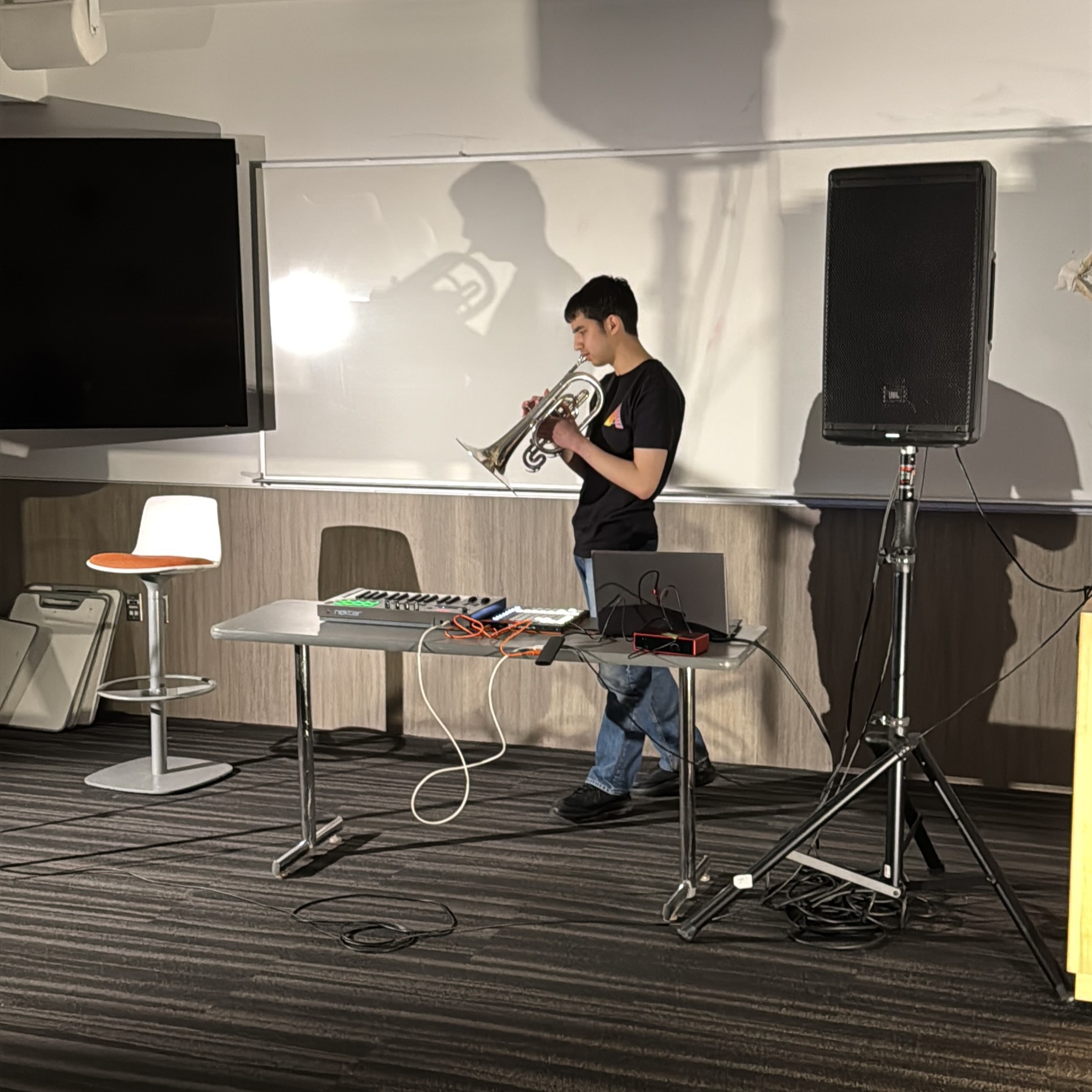melodiphone
The melodiphone is a wireless, digital musical instrument built as an extension to a mellophone. The melodiphone was designed for my final project in Digital Musical Instrument Design in Spring 2025.
concept
The melodiphone is inspired by my previous performances with live mellophone performance alongside electronic music:
I wanted to create an instrument that would give me more freedom to manipulate the backing track while playing mellophone without having to reach for my other equipment, as well as change the timbre of my playing in real time. With this in mind, the melodiphone is designed to be:
-
detachable: I, like many brass instrumentalists, loan my instrument, and thus cannot make irreversible modifications to it or adhere things to it using strong adhesives. The melodiphone must be designed so that all additions to the instrument are non-invasive to attach and easy to remove.
-
versatile: the melodiphone should provide the means for doing a plethora of manipulations to both a backing track and the live instrument.
-
mobile: the melodiphone must be able to move around while being played. To this end, it must be wireless, lightweight, and compact, and stay securely on the instrument while it is moving around.
Some ideas I had for modifications were being able to trigger recordings using only buttons and valves attached to the mellophone, which could be useful for triggering cues within a song, as well as for adding drum sounds or similar samples. I also aimed to completely change the timbre of the mellophone with the instrument, and to this end used DDSP-VST, including training custom models, to perform timbre transfer on the output.
implementation

The melodiphone consists of 4 primary parts:
- Force-sensing resistors (FSRs) are applied to the top of the instrument such that they are pressed down when the valves are depressed.
- A set of buttons is attached to a piece of Velcro tape and is attached around the valve encasing so they are accessible by the left hand while playing.
- The Arduino, battery, and protoboard with the rest of the electronics is put in a casing that is attached directly behind the bell of the instrument.
- A lavalier microphone sits inside a practice mute which dampens the outputted sound and allows it to be sent to the computer.
From these parts, we are able to get output both from the valves of the instrument and from additional buttons that can be sent to the computer, alongside the outputted sound from the instrument which can be used for further processing.
The associated Max patch is intended to be open-ended so that the sensor outputs could be used differently for different pieces being performed. Generally, the buttons can be programmed to trigger different “modes” while they are depressed, while pressing down the valves triggers different effects for each mode. For instance, in the demo performance, one button is programmed to trigger drum sounds when valves are depressed, while another sets the timbre that should be outputted during playing, either none, a preset from DDSP, or a custom DDSP model that I trained for the performance.
materials
Apart from wires, protoboards/breadboards, and the battery, the melodiphone requires these materials (or similar):
- PAMPET Trombone/French Horn Practice Mute
- KUKIHO Mic-01 Wireless Lavalier Microphone
- Arduino UNO R4 WiFi
- VELCRO 3/4 in Sticky Tape
resources
Resources are available on the melodiphone GitHub repo, including the Max patch, Arduino code, and custom DDSP model used for the final performance.
video
future improvements
While this prototype was able to show that this instrument was possible and effective, there would be several improvements needed in order to achieve the original goals of the design:
- The lavalier microphone caused a significant amount of latency which made the instrument difficult to play. Perhaps higher-end microphone models may resolve this issue, or on-board processing with the Arduino to utilize its faster wireless connection.
- The positioning of the lavalier inside of the bell and this type of lavalier caused continous clipping, cutting off much of the mellophone’s timbre. Perhaps a higher-quality microphone may be able to mitigate this.
- The FSRs very quickly wore out when being contacted continuously by the metal valves. To this end, foam or other protective material should be added to protect them from the impact.
- The current design required many wires and complex soldering that made the instrument rather precarious to play. Properly sized wires could help resolve this issue, as well as a better method for attaching the wiring to the protoboard.
- The current encasing for the Arduino, batteries, and protoboard was taken from a scrapped prototype for a previous project, which fit nicely, but not perfectly. A new encasing could be designed that better suits this particular instrument.
acknowledgements
Thank you to Stephan Moore and Kate In for advice, materials, and recording of the presentation video. Thank you as well to the Northwestern Bands program for the mellophone, and for providing me with 4 years of wonderful involvement with the band program!
